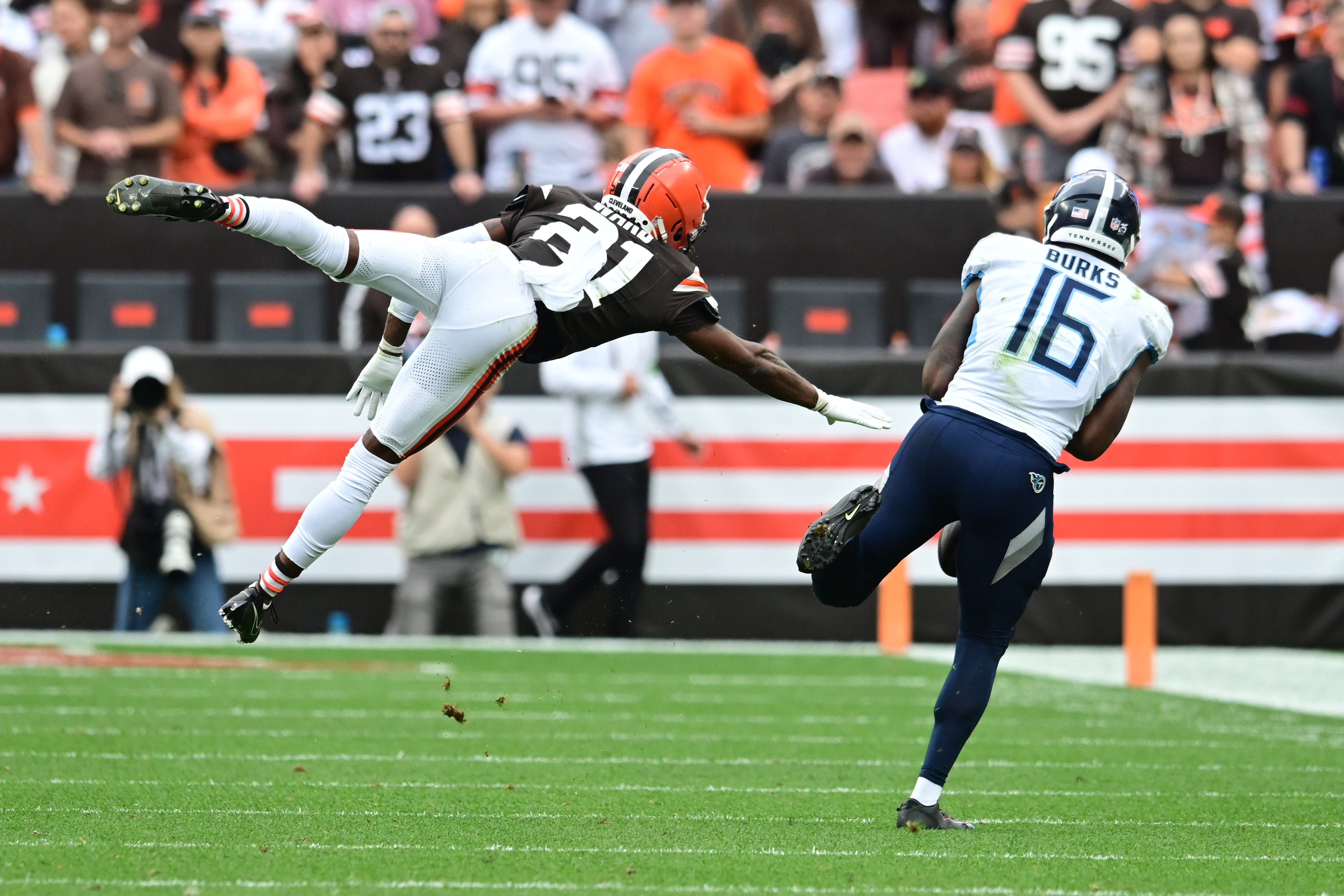By JAKE DOWNARD
Jake Downard is a law student who creates NFL and NBA content focused on analytics on Twitter as @JakeAndBall. He also works with fanspo.com. Today is his second post at PaulKuharsky.com. A glossary of the analytics terms he uses is at the bottom of the piece.
From the second quarter against the Chargers to the moment Nick Folk hit the game-winning field goal in overtime, the Titans operated as arguably the most efficient offense in football. Ryan Tannehill was lights out, the run game was successful with the sudden success in play-action passing, targets were spread beautifully throughout the depth chart, and nearly every skill position player contributed in a big way.
A week after putting together a performance that got the entire fanbase excited for the first time in a long time, the Titans imploded.

It does not take an analytical savant or advanced algorithm to conclude that they were horrible against the Browns. If you were curious, this is how their offense graded out in the advanced metrics that they were so successful in last week: [Unlocked]
- EPA/Play: -0.385 (27th out of 28 teams on Sunday).
- Success Rate: 27.7% (28th out of 28 teams on Sunday).
- Dropback EPA: -0.387 (26th out of 28 teams on Sunday).
- Dropback Success Rate: 25.0% (28th out of 28 teams on Sunday).
- Rush EPA: -0.379 (27th out of 28 teams on Sunday).
- Rush Success Rate: 33.3% (20th out of 28 teams on Sunday).
The Titans' overall offensive Success Rate was dead last on a day where one team lost by 50 points and two other teams lost by 30 or more points. Their Dropback EPA and Rush EPA both ranked bottom three in the NFL on Sunday.
Jim Schwartz loaded the box and completely eliminated any threat of the Titans gaining positive yards on obvious run plays. Myles Garrett, Jeremiah Owusu-Koramoah, and the rest of the Browns front manhandled the Titans’ offensive line on obvious passing downs, stifling any production on dropbacks. All in all, the Titans finished with 94 total yards on 45 offensive plays. Their only scoring drive on the day was a drive where they recorded -9 yards.
Now that we’ve gone over a brief overview of how bad things were, let’s dive into the offensive line and how each individual lineman graded out this week. Per Pro Football Focus, this is how the Titans offensive line graded out this week:
- Aaron Brewer (C): 60.9 OVR, 68.2 PBLK, 57.3 RBLK.
- Daniel Brunskill (RG): 59.5 OVR, 69.2 PBLK, 53.7 RBLK.
- Chris Hubbard (RT): 58.1 OVR, 49.5 PBLK, 62.4 RBLK.
- Dillon Radunz (LG): 49.6 OVR, 27.4 PBLK, 58.8 RBLK.
- Andre Dillard (LT): 37.2 OVR, 26.2 PBLK, 56.0 RBLK.
On Tannehill’s 30 dropbacks, the Cleveland front pressured him 50% of the time. Here is who Pro Football Focus assessed those pressures to:
- Dillard: 7 pressures, 3 sacks allowed.
- Hubbard: 3 pressures, 2 sacks allowed.
- Radunz: 3 pressures, 0 sacks allowed.
- Aaron Brewer: 1 pressure, 0 sacks allowed.
- Daniel Brunskill: 0 pressures, 0 sacks allowed.
(Blake Beddingfield broke down the sacks in his game review.)
While the inside and right side of the offensive line could have certainly been better, Andre Dillard was pretty clearly the biggest issue. As a result, Ryan Tannehill got rid of the ball very quickly. He finished the game on Sunday with the fifth-fastest average time to throw in the NFL at 2.37 seconds. Despite getting the ball out at a very quickly, Tannehill came in at seventh among starters in Average Depth of Target.
In other words, Tannehill got the ball out quickly on Sunday, but he also threw the ball downfield more than most quarterbacks. This weird quirk can likely be attributed to the Titans' abhorrent third-down percentage (2/12) and Tannehill being forced to throw downfield to try to convert in third-and-long situations.
When the Titans promoted Tim Kelly, I expected a lot of pre-snap motion and short routes that were almost an extension of the run game. Many of the NFL’s best play-callers (Andy Reid, Mike McDaniel, Kyle Shanahan) have made a living on finding ways to get the ball into the hands of their playmakers quickly and efficiently in order to create opportunities for second-and-short and third-and-short situations.
It almost seems like these play-callers have discovered and employed a hybrid run/pass play into their offensive repertoire. These quick passes, shovels, screens, outs, and short drag routes allow their weapons to build confidence and pick up chunk yardage on early downs, their quarterbacks to get in rhythm, and the opposing defensive line to burn up energy on reps where they have essentially no chance at getting to the quarterback.
In a game where the Titans were pressured seemingly non-stop, Tannehill’s Air Yards on first and second downs were 9.2, sixth in the NFL on Sunday. His EPA/play on those downs was -0.398, dead last in the NFL, and his CPOE was -11.7%, 27th out of 29 QBs. The Titans also had the second-lowest Rush EPA on first and second downs against the Browns.
When airing it out isn’t working due to the offensive line allowing so much pressure, and Schwartz is loading the box down to stop the run game, why not explore the short passing game more and try to get into manageable situations on third down?
The target shares of the Titans’ skill position group against the Chargers were beautiful. This week, we saw the Titans attempt to do more of the same, rather than force-feeding DeAndre Hopkins as they did in Week One. Here are the respective target shares of each player who registered a target against the Browns:
- DeAndre Hopkins: 7 targets (29.1%)
- Treylon Burks: 6 targets (25.0%)
- Chig Okonkwo: 4 targets (16.7%)
- Tyjae Spears: 4 targets (16.7%)
- Chris Moore: 3 targets (12.5%)
On top of the target share spread, here is how each respective player graded on Pro Football Focus solely as a receiver, with no blocking factored in (sorry, Vrabes):
- Chris Moore: 74.4 RECV
- DeAndre Hopkins: 72.3 RECV
- Tyjae Spears: 59.6 RECV
- Chig Okonkwo: 46.3 RECV
- Treylon Burks: 42.7 RECV
Kelly, Burks, and Okonkwo have to be better if this offense is going to work its way into league-average territory. Kelly has to find ways to get the ball into the hands of his young playmakers, who have shown the ability to succeed after the catch.
At the same time, Burks and Okonkwo have to find ways to separate from defenders and catch the ball. According to Pro Football Focus, Burks dropped two on-target passes on Sunday. Burks also registered an Average Depth of Target (ADOT) of 18.0. I would love to see Kelly get the ball in Burks’ hands behind, or around, the line of scrimmage and allow him to work after the catch against DBs on the boundary, where he often times has a size and strength advantage.
Okonkwo, on the other hand, registered an ADOT of -0.3. While the Titans have had some success over the last two seasons getting him the ball behind or around the line of scrimmage, his speed oftentimes makes him a mismatch with the defenders who cover him. With a loaded-down box, multiple defenders in the area, and Okonkwo lining up either inline or in the slot on 75.9% of snaps, it is hard to expect him to generate yardage after the catch.
If the offensive line can buy Tannehill a little more time, I would expect Okonkwo’s targets downfield and across the middle to increase as he has more time to separate from his matchups in coverage before the ball is thrown.
A week after putting together a truly well-rounded offensive performance, we once again saw a team reeling for some sense of rhythm and continuity.
The Titans played like the team that has lost nine of its last 10 games, not the team that just beat a playoff contender and matched its most points scored since Week 11 of 2022. The offensive line, QB play, run game, play-calling, and secondary weapons were all wildly disappointing a week after the matchup with the Chargers.
The theme following losses in the Vrabel era has oftentimes been to “coach better and play better.” If the Titans don’t take that sentiment to heart, this season could get out of hand quickly. As they gear up to host the Cincinnati Bengals, everyone on offense has to be better.
TERMS
EPA/ Expected Points Added: Per Pro Football Focus, EPA is “the difference in Expected Points before and after each play. Expected Points is an estimate of how many points a team will score on a drive, given the current situation (down, distance, time remaining, etc.).” In other words, if a team has a big punt return and starts its drive on the opponent’s 20-yard line, its Expected Points on that drive are higher than they would be if the opposing punter pinned it inside its own 5-yard line. Put succinctly, a positive EPA means a player is contributing to putting points on the board.
EPA/play: Expected Points Added per play.
CPOE: Completion Percentage Over Expected. This metric factors in the air yardage, coverage, routes, and more to create an expected benchmark completion percentage. Obviously, the higher your completion percentage is, the better. ut CPOE creates a benchmark, and in turn, gives more credit to passes completed 40 yards downfield than check-downs to an open RB at the line of scrimmage. If a quarterback’s CPOE is +5.5%, that quarterback completed 5.5% more passes than expected.
Success Rate: A metric that grades each individual play based on the situation. For example, a 2-yard carry on fourth-and-1 may be deemed a successful play whereas the same 2-yard run on third-and-13 would be deemed an unsuccessful play.
Air Yards: An average of the distance a quarterback’s passes travel beyond the line of scrimmage, in the air.











You are not authorised to post comments.